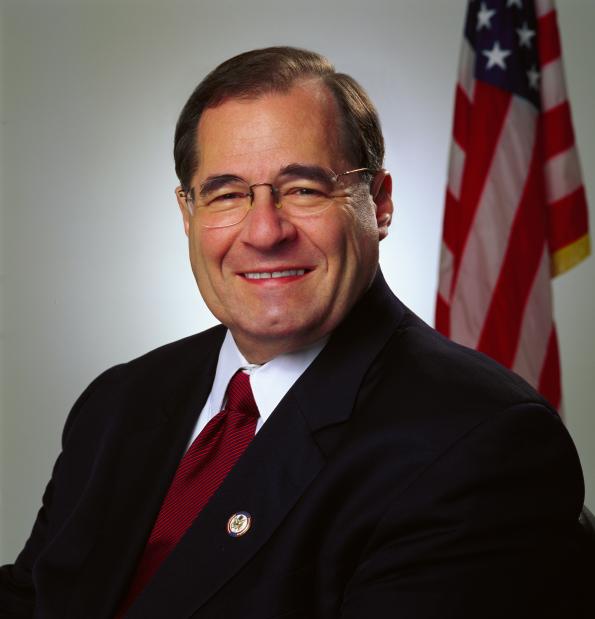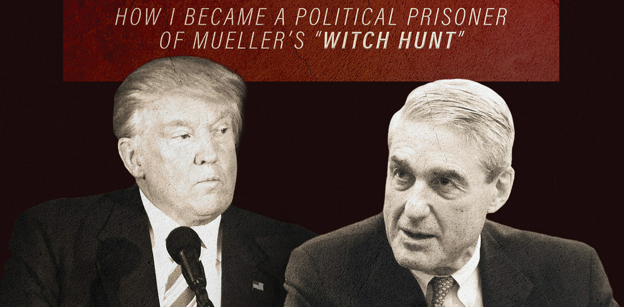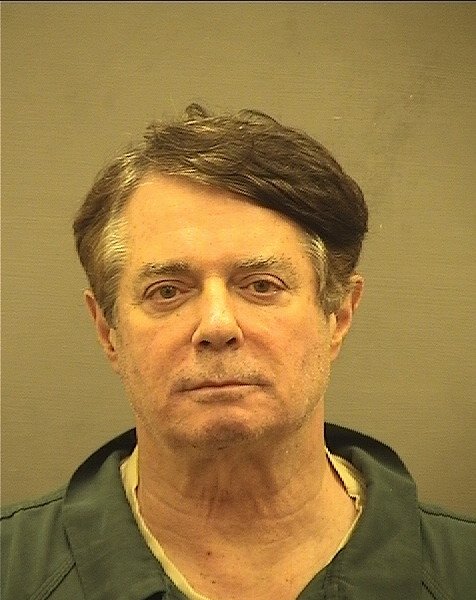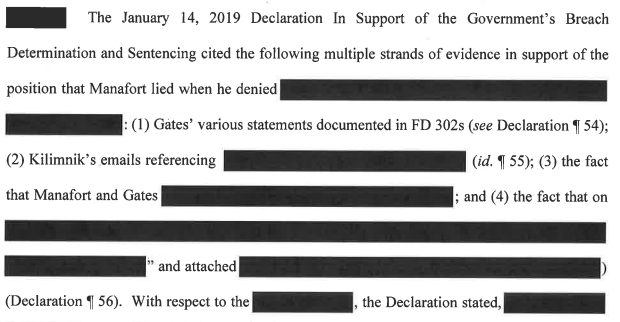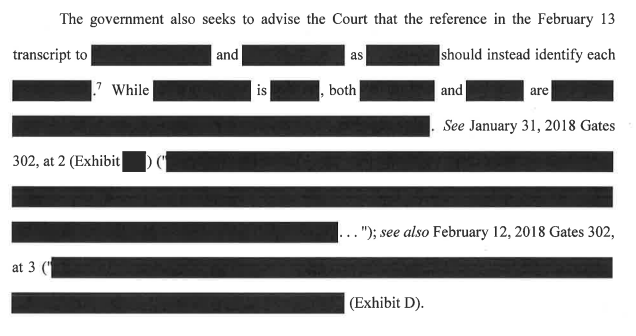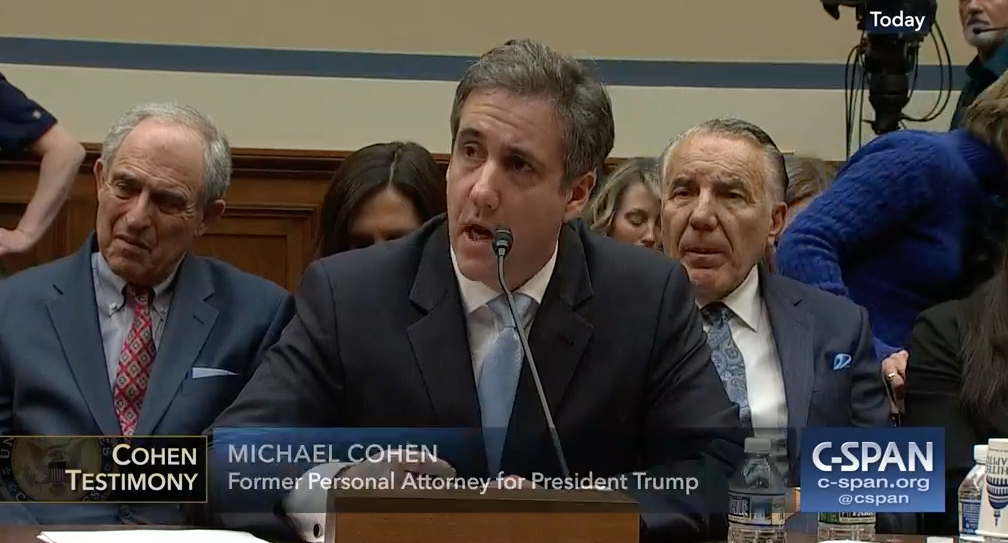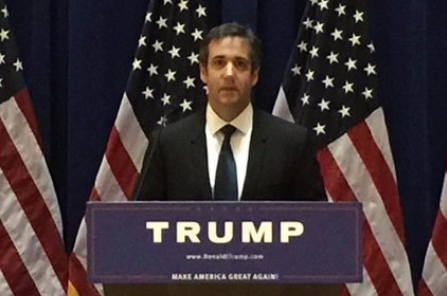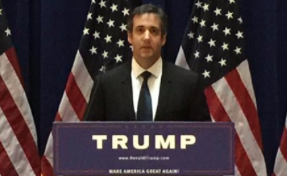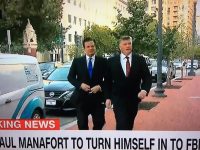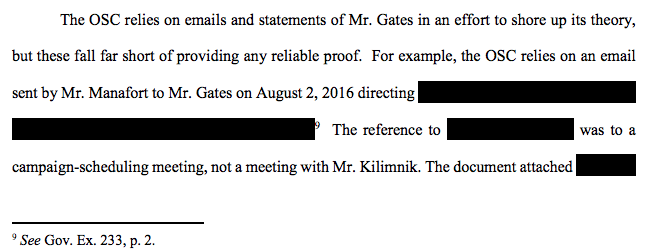I’ll be honest with you. The reason I did this post — showing that the polling data Paul Manafort shared with Konstantin Kilimnik on August 2, 2016 amounted to at least 75 pages — (and a whole lot of background work not shown) was because I wanted to puzzle through the NYT’s latest story on what Manafort shared with Kilimnik when. Ken Vogel (who bylined both the other stories repeating the cover story someone fed them in January), perhaps faced with mounting evidence they got lied to, now says Manafort shared polling data with Kilimnik twice, once at the May meeting they had, and again at the August one.
And around the same time that he was passing through Washington nearly three years ago — just as Mr. Trump was clinching the Republican presidential nomination — he first received polling data about the 2016 election from two top Trump campaign officials, Mr. Manafort and Rick Gates, as Russia was beginning a social media operation intended to help Mr. Trump’s campaign.
[snip]
Around the time of Mr. Kilimnik’s trip to the United States in spring 2016, Mr. Manafort directed Mr. Gates to transfer some polling data to Mr. Kilimnik, including public polling and some developed by a private polling company working for the campaign, according to a person with knowledge of the arrangement.
Mr. Manafort asked Mr. Gates to tell Mr. Kilimnik to pass the data to Mr. Lyovochkin and Mr. Akhmetov, the person said. Representatives for both Mr. Lyovochkin and Mr. Akhmetov said they neither requested nor received the data, and would have had no use for it.
Mr. Mueller’s team has focused on what appears to have been another discussion about polling data in New York on Aug. 2, 2016. A partly redacted court transcript suggests that Mr. Gates, who entered a plea agreement with the special counsel that requires his cooperation, may have told prosecutors that Mr. Manafort had walked Mr. Kilimnik through detailed polling data at a meeting that day in the cigar lounge of the Grand Havana Room in Manhattan.
The meeting also included a conversation about one Ukrainian “peace plan,” according to court filings.
I think if Vogel were more confident about this, it’d be the lede. BREAKING: suspected Russian asset got Trump’s polling data over and over.
Instead, Vogel tries to finesse the earlier report — which this coverage unambiguously marks as an error — so as to pretend that when the NYT reported that a court filing referred to Manafort sharing polling data with Kilimnik, the court filing meant that had happened in spring, not August. The court dispute — as Vogel’s reference to Mueller’s team’s focus now concedes — all pertains to August.
The publication history of the NYT “correction”
Side note: the publishing history of the original January 8 NYT article is of particular interest, especially since the Newsdiffs site apparently didn’t track this article, According to the Internet archive, the original story (bylined by Sharon LaFraniere and Ken Vogel) posted by 20:22 on January 8. The only description of the polling data comes in the lede:
Paul Manafort shared Trump campaign polling data with an associate tied to Russian intelligence during the 2016 campaign, prosecutors alleged, according to a court filing unsealed on Tuesday.
The first version of the story to include more detail posted at 3:51 on January 9. This is the first version that includes Maggie Haberman on the byline (and Scott Shane and Andrew Kramer as contributors). This is the version that said Manafort knew Kilimnik was going to share the data with Oleg Deripaska. But it also introduces two things that are inaccurate: the timing, and that the data was public.
As a top official in President Trump’s campaign, Paul Manafort shared political polling data with a business associate tied to Russian intelligence, according to a court filing unsealed on Tuesday. The document provided the clearest evidence to date that the Trump campaign may have tried to coordinate with Russians during the 2016 presidential race.
[snip]
The document gave no indication of whether Mr. Trump was aware of the data transfer or how Mr. Kilimnik might have used the information. But from March to August 2016, when Mr. Manafort worked for the Trump campaign, Russia was engaged in a full-fledged operation using social media, stolen emails and other tactics to boost Mr. Trump, attack Mrs. Clinton and play on divisive issues such as race and guns. Polling data could conceivably have helped Russia hone those messages and target audiences to help swing votes to Mr. Trump.
Both Mr. Manafort and Rick Gates, the deputy campaign manager, transferred the data to Mr. Kilimnik in the spring of 2016 as Mr. Trump clinched the Republican presidential nomination, according to a person knowledgeable about the situation. Most of the data was public, but some of it was developed by a private polling firm working for the campaign, according to the person.
Mr. Manafort asked Mr. Gates to tell Mr. Kilimnik to pass the data to Oleg V. Deripaska, a Russian oligarch who is close to the Kremlin and who has claimed that Mr. Manafort owed him money from a failed business venture, the person said. It is unclear whether Mr. Manafort was acting at the campaign’s behest or independently, trying to gain favor with someone to whom he was deeply in debt. [my emphasis]
So at that point, the story was:
- Byline includes Maggie for the first time
- Shared in spring
- Mostly public
- Intended for Deripaska
The story posts in a “corrected” form sometime before 19:23 on January 9. It retains the timing and public data claims, but changes the recipient with a “correction,” even while retaining an earlier paragraph about Deripaska that (particularly given the August handoff) should disprove the “correction.” It also adds a paragraph effectively admitting that it isn’t as obvious why two Ukrainian oligarchs would want the polling data in the way that Deripaska would have an obvious use for it.
About the same time, Mr. Manafort was also trying to curry favor with Oleg V. Deripaska, a Russian billionaire close to the Kremlin and an associate of Mr. Kilimnik. In July 2016, Mr. Manafort, then the Trump campaign chairman, told Mr. Kilimnik that he could offer Mr. Deripaska “private briefings,” according to emails reported by The Washington Post. Mr. Deripaska had claimed Mr. Manafort owed him millions from a failed business venture, and Mr. Manafort may have been trying to use his status in the campaign to hold him at bay.
[snip]
Mr. Manafort asked Mr. Gates to tell Mr. Kilimnik to pass the data to two Ukrainian oligarchs, Serhiy Lyovochkin and Rinat Akhmetov, the person said. The oligarchs, neither of whom responded to requests for comment, had financed Russian-aligned Ukrainian political parties that had hired Mr. Manafort as a political consultant.
Why Mr. Manafort wanted them to see American polling data is unclear. He might have hoped that any proof that he was managing a winning candidate would help him collect money he claimed to be owed for his work on behalf of the Ukrainian parties.
[snip]
A previous version of this article misidentified the people to whom Paul Manafort wanted a Russian associate to send polling data. Mr. Manafort wanted the data sent to two Ukrainian oligarchs, Serhiy Lyovochkin and Rinat Akhmetov, not Oleg V. Deripaska, a Russian oligarch close to the Kremlin.
There’s a part of me that wonders whether NYT was not so obstinate on the issue of this data being public and shared in spring because they’ve seen lawyers notes or even the 302 of Manafort’s testimony that Amy Berman Jackson has since ruled to be a lie. They’re still sourcing the claim to one individual in the know, which seems like pretty shaky sourcing to ignore after the plain language of the official court transcript of the February 4 hearing made it clear this was an August hand-off. So it may be they’ve got a non-public document that leads them to believe this is the case, even if that non-public document is just a record of Manafort lying.
Weissmann may have corrected the NYT in the breach determination hearing
But we know that after the NYT story, with its prominent Deripaska claim followed by its “correction,” the government submitted a declaration on January 15 in which most of the discussion of polling data was entirely redacted, then argued the point at length on February 4. In addition to Richard Westling’s comments that make it clear this wasn’t mostly public data, Andrew Weissmann argued (in passage that was mistakenly attributed to Westling in the transcript), that Manafort knew the data would be shared with two entities.
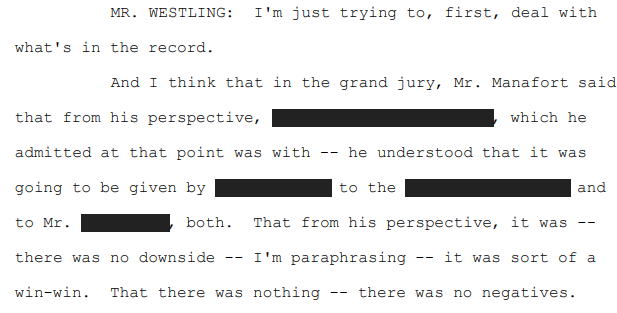
As noted, the last redaction in this passage would fit neither of the Ukrainian oligarchs named but would fit Deripaska, though that’s just one possibility. That said, given that the meeting was on August 2, in the context of Manafort “getting whole” with Deripaska, it would be inconceivable that Kilimnik would share the data only with the Ukrainians.
In addition to saying that Manafort was telling the lies he told in a bid to sustain hopes for a pardon, Weissmann also makes a reference to a lie told “three weeks ago.” Given the redaction fail, we can be certain that nothing in the Manafort filing (which was technically more than three weeks before the hearing) could be that lie. But the “correction” to the NYT could be.
Weissmann also moves directly from that discussion to an assertion that the question of sharing polling data went straight to the heart of Mueller’s mandate — investigating “witting or unwitting” coordination with Russia.
MR. WEISSMANN: So — so, first, in terms of the what it is that the special counsel is tasked with doing, as the Court knows from having that case litigated before you, is that there are different aspects to what we have to look at, and one is Russian efforts to interfere with the election, and the other is contacts, witting or unwitting, by Americans with Russia, and then whether there was — those contacts were more intentional or not. And for us, the issue of [2.5 lines redacted] is in the core of what it is that the special counsel is supposed to be investigating.
And we know from Amy Berman Jackson’s breach determination ruling that she found this was indeed a link with Russia — not Russian backed oligarchs, but Russia.
That’s circumstantial, but it seems that Weissmann was rebutting the notion that Manafort intended Kilimnik to share this information exclusively with Ukrainians, and not Russians. Whatever the case, ABJ has ruled that the sharing of this data did entail a link with the Russian government.
Manafort invokes some earlier meeting as a last ditch ploy in his final filing
Which brings me to ABJ’s mention of a totally new argument that Manafort apparently raised in their final brief.
Some background to this brief. During the debate over the polling data on February 4, Manafort’s lawyers tried to rebut the claim first by Richard Westling spinning the data, then by Kevin Downing claiming that Rick Gates had no credibility, as proven (he claimed) by Gates’ flop before the EDVA jury. ABJ then, on her own, gets the public report from a juror on the EDVA jury to prove Downing’s attacks are overblown. Through it all, the possibility that Gates might be called in to testify on this issue (which of course would allow ABJ to decide that he’s way more credible than Manafort, but then most people are). Ultimately, Manafort’s lawyers say they don’t want that to happen, but say they’ll submit one more brief.
That’s the one I cited in this post, referencing the polling data and Kilimnik’s emails about them. According to ABJ in her judgment hearing, after the entire breach determination was done, Manafort’s team tried to make a totally new argument about what Manafort was saying when he told Gates to print out the polling data.
More important to me, there’s other corroboration. There’s Exhibit 233, an [redacted — remember, this exhibit is the email with polling data attached] Now, I was told on February 8th, for the first time, in the third pleading that was filed in response to these allegations and after the hearing was over, that when Mr. Manafort said [3 lines redacted] There’s nothing provided to substantiate that, but there’s also nothing in the record to indicate one way or the other that the two men had met previously [redacted]
All Gates said to the FBI in Exhibit 236 on January 30th was that [redacted]. Is that text alone definitive? Am I relying on that solely? No. But is it corroborative of Gates’s statement that [redacted] Yes.
This seems to be an effort to suggest that the first three times Gates claimed Manafort shared polling data in proffer sessions in January and February 2018 he was saying something different than what he was saying in what they claim was a brand new claim on September 28, in testimony parallel to Manafort’s own. There’s nothing in the unredacted passages of that filing that explain this argument (though it does reference data from “prior to the Republican Convention and the start of the General Election,” which could be July 15 or could be May 2.
Ultimately, the ploy doesn’t work. ABJ goes through two different Gates 302s from January and another (which may be the stuff that had been ex parte at the February 4 hearing) from February 7, 2018 that all corroborate that Manafort ordered Gates to print out the polling data to be shared at that August 2 meeting.
I’m interested in this for two reasons. First, this new argument, made a month after someone first gave a false story to the NYT, seems to be referencing an earlier meeting between … somebody. Maybe Gates and Kilimnik?
But I do find that to be an interesting detail for two reasons. First, as noted, the NYT story, without correcting their initial outright error that the court dispute pertained to the August 2 meeting, now claims that Manafort directed Gates to deal poll data twice, once in May and once in August.
And around the same time that he was passing through Washington nearly three years ago — just as Mr. Trump was clinching the Republican presidential nomination — he first received polling data about the 2016 election from two top Trump campaign officials, Mr. Manafort and Rick Gates, as Russia was beginning a social media operation intended to help Mr. Trump’s campaign.
[snip]
Around the time of Mr. Kilimnik’s trip to the United States in spring 2016, Mr. Manafort directed Mr. Gates to transfer some polling data to Mr. Kilimnik, including public polling and some developed by a private polling company working for the campaign, according to a person with knowledge of the arrangement.
Mr. Manafort asked Mr. Gates to tell Mr. Kilimnik to pass the data to Mr. Lyovochkin and Mr. Akhmetov, the person said. Representatives for both Mr. Lyovochkin and Mr. Akhmetov said they neither requested nor received the data, and would have had no use for it.
Is that what Manafort’s team invented at this late date? A claim that the reference in the August 2 email to sharing data with Kilimnik was about a meeting that had transpired three months earlier?!?!
The May Kilimnik meeting never shows up in the breach determination
But it does raise some interesting questions. Notably, it’s not clear whether the May 2016 meeting between Manafort and Kilimnik came up at all during his cooperation.
The government’s January 15 declaration sets a start date on Manafort’s lies, “Beginning on August 2, 2016, and continuing until March 2018, Manafort and Kilimnik communicated about a [peace deal],” but that seems to relate exclusively to that peace deal. It doesn’t rule out a discussion of that earlier meeting (though it does seem to rule out Mueller knowing that Ukrainian sanctions came up, which actually is a good thing for Trump given the stink around the Ukrainian language in the Republican platform in July).
Which leaves three possibilities, apart from Manafort’s efforts to separate the sharing of polling data from the discussions about a Ukraine peace deal.
- Prosecutors didn’t discuss the May meeting at all with Manafort during his cooperation
- Prosecutors discussed the May meeting with Manafort (which may have included a meeting with Trump) and he told the truth about it
- Manafort lied about the May meeting, but prosecutors didn’t want to lay out what they really know about it
All would be interesting. I mean, even aside from the possibility that Trump met Kilimnik, the early May meeting should be of significant interest because at least two other events closely coincide with it:
- On May 4, Ivan Timofeev tells George Papadopoulos he has been cleared to start negotiations with Papadopoulos, which leads him to forward an email discussing such an offer to multiple people on the campaign, including (on May 21), Manafort
- After their discussions about a Trump Tower had moved to Dust between January and May, Felix Sater sends Michael Cohen texts moving to set up his and Trump’s trips to Moscow.
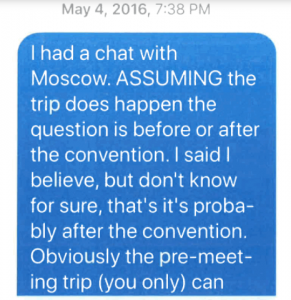
In other words, May 4 or thereabouts, just a week after the Russians first dangled the emails to Papadopoulos, the plot appears to start up again. That coinkydink of significant events would seem to be something prosecutors would want to discuss with Manafort.
If they did, they’re not telling us whether he told the truth.
As I disclosed last July, I provided information to the FBI on issues related to the Mueller investigation, so I’m going to include disclosure statements on Mueller investigation posts from here on out. I will include the disclosure whether or not the stuff I shared with the FBI pertains to the subject of the post.

